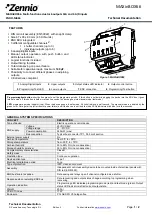
Wi-Fi&Bluetooth Module Series
FC80A_Hardware_Design 48 / 43
e) Test procedures for design verification; and
f) Production test procedures for ensuring compliance.
The module grantee shall provide a notice that any deviation(s) from the defined parameters of
the antenna trace, as described by the instructions, require that the host product manufacturer
must notify the module grantee that they wish to change the antenna trace design. In this case, a
Class II permissive change application is required to be filed by the grantee, or the host
manufacturer can take responsibility through the change in FCC ID (new application) procedure
followed by a Class II permissive change application.
Explanation: Yes, The module with trace antenna designs,refer to the RF Link schematic
diagram and refer to PCB Layout.
2.6 RF exposure considerations
It is essential for module grantees to clearly and explicitly state the RF exposure conditions that
permit a host product manufacturer to use the module. Two types of instructions are required for
RF exposure information:
(1) to the host product manufacturer, to define the application conditions (mobile, portable
–
xx cm from a person
’s body); and (2) additional text needed for the host product manufacturer
to provide to end users in their end-product manuals. If RF exposure statements and use
conditions are not provided, then the host product manufacturer is required to take
responsibility of the module through a change in FCC ID (new application).
Explanation: This module complies with FCC RF radiation exposure limits set forth for an
uncontrolled environment, This equipment should be installed and operated with a minimum
distance of 20 centimeters between the radiator and your body." This module is designed to
comply with the FCC statement, FCC ID is: XMR2022FC80A.
2.7 Antennas
A list of antennas included in the application for certification must be provided in the instructions.
For modular transmitters approved as limited modules, all applicable professional installer
instructions must be included as part of the information to the host product manufacturer. The
antenna list shall also identify the antenna types (monopole, PIFA, dipole, etc. (note that for
example an
“omni-directional antenna” is not considered to be a specific “antenna type”)).
For situations where the host product manufacturer is responsible for an external connector, for
example with an RF pin and antenna trace design, the integration instructions shall inform the
installer that unique antenna connector must be used on the Part 15 authorized transmitters
used in the host product. The module manufacturers shall provide a list of acceptable unique
connectors.
Explanation: The EUT has a Dipople Antenna.the customer can use the Dipople antenna
,as
list




































